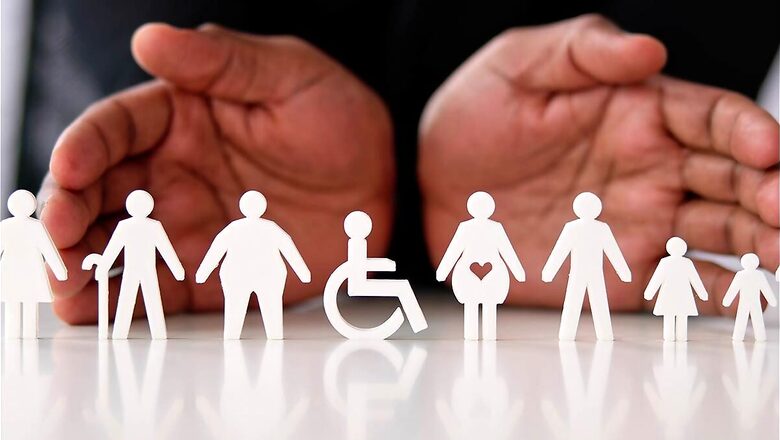
views
“In the journey of self-discovery, when we embrace our true selves without the need for change, a profound transformation occurs.” This powerful quote from J. Krishnamurti, the renowned Indian philosopher, resonates deeply with embracing authenticity and honouring diverse human experiences. In a world often burdened by rigid and oppressive gender norms, countless individuals struggle to express their true selves, enduring discrimination and violence because their uniqueness is misunderstood. To challenge these norms and cultivate inclusivity, we need more dialogue, more understanding, more concrete steps in normalising the gender spectrum.
One powerful and transformative step in this direction, is the provision of gender-neutral toilets in public and community settings. These toilets break the binary construct of gender by ensuring that everyone is welcome, irrespective of their biological sex, their gender identity or their height, their weight, their skin colour, their political views or anything else. In doing so, they create spaces where we are all welcome, and for the transgender, non-binary and intersex individuals amongst us, they create islands of safety and acceptance.
Why is there a need for gender-neutral toilet facilities?
Gender-neutral toilet facilities offer numerous advantages for both individuals and communities:
- Promoting dignity and human rights: By acknowledging that everyone has the right to access safe and hygienic toilets that are free from harassment, violence, or humiliation, gender-neutral toilet facilities uphold human rights. They embrace the understanding that gender extends beyond a binary concept, encompassing a diverse spectrum of identities and expressions deserving of respect and recognition.
- Fostering inclusion and diversity: Gender-neutral toilet facilities create environments where individuals of various genders and orientations coexist harmoniously and comfortably. They send a powerful message that all individuals, regardless of their gender identity or expression, are not only welcome but also valued in public and community settings.
- Reducing stigma and discrimination: By normalising the gender spectrum, these toilets challenge stereotypes and prejudices associated with specific genders and their corresponding roles, behaviours, and expectations. They combat the stigma and discrimination faced by transgender and non-binary individuals by taking away the problem of having to choose between a ‘gents’ or ‘ladies’ toilet, both of which exclude transgender, intersex and non-binary individuals.
- Improving health and well-being: For transgender, intersex and non-binary individuals, the experience of going to a gendered toilet is always fraught with stress – irrespective of which toilet they choose to use, there is always a chance that their presence will be challenged, that they will be humiliated, called out, or even verbally and/or physically attacked. This causes many people to just ‘hold it’, and not go to the toilet altogether, creating a whole host of physical problems ranging from urinary tract infections, kidney problems, constipation and even dehydration. Gender neutral toilets prevent all of this.
- Increasing efficiency and convenience: In public and community settings, gender-neutral toilet facilities improve the efficiency and convenience of restroom use. By minimising waiting times, especially for women who often face long queues outside female-only restrooms, these facilities create a more streamlined experience. Moreover, by eliminating the need for separate restrooms based on gender, gender-neutral facilities save space, financial resources, and other valuable assets.
What challenges and barriers hinder the adoption of gender-neutral toilet facilities in India?
Despite the manifold benefits of gender-neutral toilet facilities, numerous challenges and barriers impede their widespread adoption and implementation in India. Some of these obstacles include:
- Lack of awareness and understanding: Many individuals in India remain unaware of or do not comprehend the concept of gender-neutral toilet facilities, as well as the needs and rights of transgender and non-binary individuals. Misconceptions and apprehensions regarding the sharing of restrooms with individuals of different genders or orientations persist.
- Lack of legal recognition and protection: India lacks a comprehensive law that recognizes and safeguards the rights of transgender and non-binary individuals, including their right to access public services such as sanitation. The Transgender Persons (Protection of Rights) Act, 2019, passed by the Parliament, has drawn criticism from activists for being inadequate, discriminatory, and infringing upon human rights.
- Lack of social support: Many politicians, policymakers, administrators, service providers, and civil society organisations in India exhibit limited political will or social support for promoting or implementing gender-neutral toilet facilities in public and community settings. Opposition or resistance from conservative, religious groups, or segments of society indifferent or hostile to the cause of gender diversity further compounds these challenges.
How can we overcome these challenges and barriers?
Despite the formidable challenges and barriers, viable solutions exist to make gender-neutral toilet facilities a reality in India. Key strategies to overcome these obstacles include:
- Raising awareness and understanding: Through various media platforms and channels, such as social media, print media, radio, television, posters, flyers, workshops, seminars, and campaigns, we can disseminate information and educate diverse stakeholders and segments of society about gender-neutral toilet facilities and the needs and rights of transgender and non-binary individuals.
- Advocating for legal recognition and protection: By advocating for comprehensive legal recognition and protection of the rights of transgender and non-binary individuals, including their right to access public services like sanitation, we can engage with governmental bodies, the judiciary, legislature, and other authorities. Lobbying for the enactment or amendment of inclusive laws, policies, guidelines, and regulations that respect and honour gender diversity and identity is vital.
- Building social support: To promote and implement gender-neutral toilet facilities in public and community settings, engaging with politicians, policymakers, administrators, service providers, and civil society organisations is essential. By persuading these stakeholders to support the cause and mobilising public opinion through petitions, protests, rallies, and marches, we can cultivate political will and social support.
- Improving infrastructure and resources: Collaboration with the government, private sector, NGOs, and other stakeholders is crucial for enhancing infrastructure and resources necessary for gender-neutral toilet facilities in public and community settings. By designing, constructing, renovating, maintaining, and managing accessible, safe, hygienic, and comfortable restrooms, we ensure that they meet the needs of all users. Equipping these facilities with essential features like running water, soap, sanitary napkins, waste bins, locks, and lights is also paramount.
What are some examples of successful initiatives and best practices?
Inspiring initiatives and best practices from around the world and within India serve as shining examples, motivating action. A few notable instances are:
- The Swachh Bharat Mission (SBM): This flagship program of the Government of India strives for universal sanitation coverage. Through the construction of toilets in rural and urban areas, including public and community facilities, the SBM has made significant strides. Today, every Indian has access to a toilet. Additionally, behaviour change communication and social mobilisation campaigns are promoting toilet usage and safe sanitation practices.
- Educational Institutions: The seeds of change are being sown in educational institutions, where spirited student groups advocate for gender-neutral restrooms. IIT Bombay and Tata Institute of Social Sciences in Mumbai, led by their respective LGBTQ+ student support groups, Saathi and Queer Collective, were pioneers in this movement, installing gender-neutral restrooms in 2017. These trailblazing examples emphasise the transformative power of unity and collaboration. Other Indian universities are also weaving gender-neutral spaces and accommodations into the fabric of their campuses. IIT Delhi proudly now has 14 gender-neutral washrooms, a testament to their unwavering commitment to inclusivity. Furthermore, Tezpur University in Assam and the National Academy of Legal Studies and Research (NALSAR) in Andhra Pradesh have also adopted gender-neutral washrooms.
- Gender-neutral offices: India’s Supreme Court recently set up nine gender-neutral bathrooms on its premises. In Delhi, the government has taken a significant step towards inclusivity by mandating that all its departments, offices, district authorities, municipal corporations, state-run companies, and the Delhi Police have separate and exclusive washrooms for transgender persons. The New Delhi Municipal Council (NDMC) allocated funds for the provision of separate public toilets exclusively for the transgender community in its annual budget for 2021-22. This decision reflects progress toward acknowledging and addressing the specific needs of the transgender, intersex and non-binary community.
- The Harpic Mission Swacchta aur Paani (MSP): Creating awareness about the struggles faced by LGBTQ+ individuals and sensitising the public and policymakers is essential. Initiatives like Harpic and News18’s Mission Swachhta aur Paani transcends the concept of cleanliness alone. Mission Swachhta aur Paani is a movement that recognizes the profound significance of toilets, viewing them not merely as functional spaces but as beacons of safety and acceptance for all of us. This exceptional mission is built upon the firm belief that clean and inclusive toilets are vital for fostering a society that embraces and empowers us all, unconditionally. With unwavering dedication, Harpic and News18 actively advocate for the LGBTQ+ community, propelling the message that every individual deserves access to safe and accepting spaces, where their dignity is upheld, and their presence is welcomed. The movement builds itself from the ground up: conversations led to understanding, understanding led to acceptance, acceptance led to advocacy.
Conclusion
Gender-neutral toilet facilities play a vital role in breaking down restrictive gender norms and establishing inclusive spaces for individuals of all genders and orientations. By promoting dignity and human rights, fostering inclusion and diversity, reducing stigma and discrimination, improving health and well-being, and increasing efficiency and convenience, these facilities help us build a more equitable and respectful society.

















Comments
0 comment